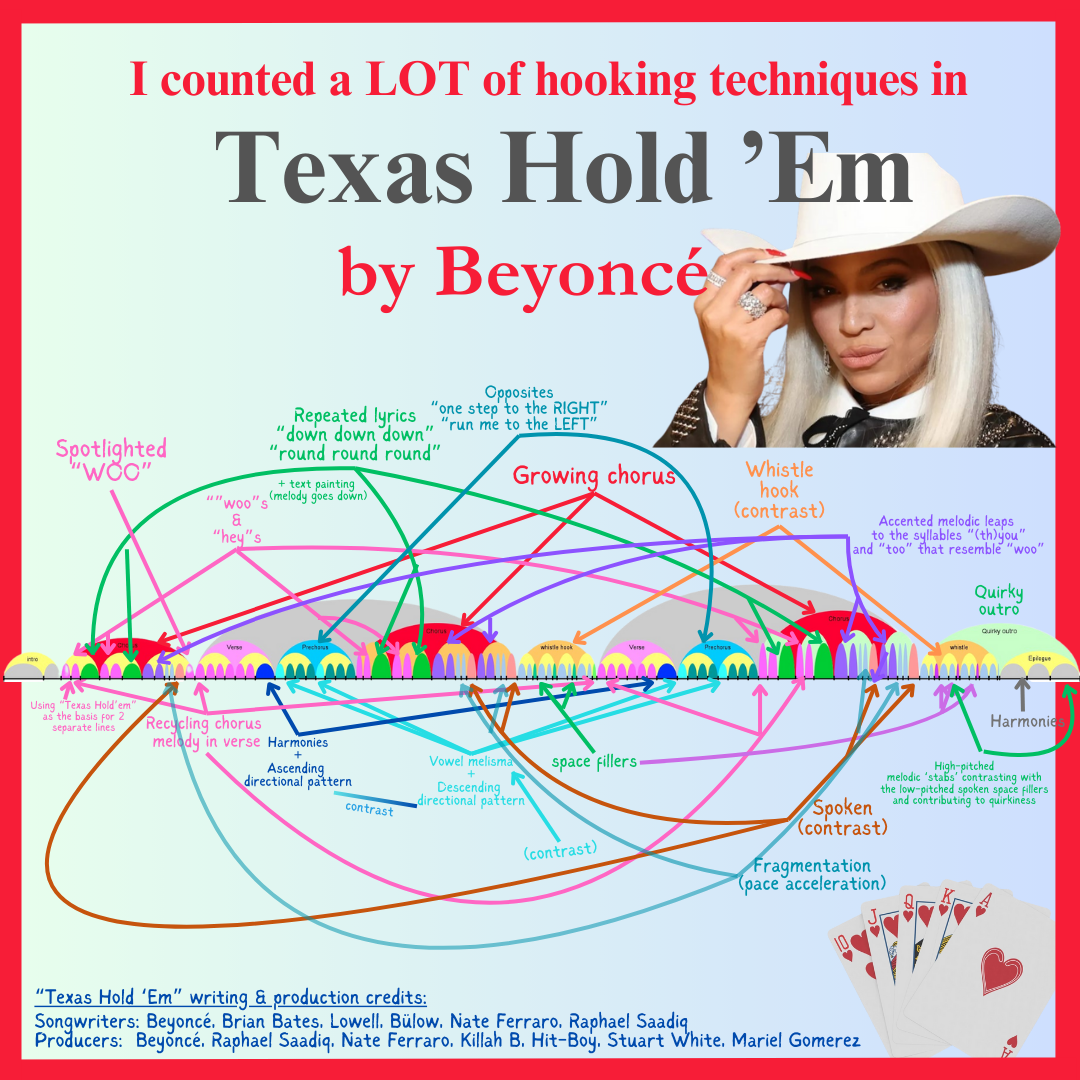I'm a bit late to the “Texas Hold ‘Em” party. I only got around to listening to Beyoncé's new hit song a few days ago, but it's been stuck in my head ever since.
So, I did what any well-adjusted person would do, and I loaded the song into my favorite structure visualization software,
Variations Audio Timeliner, and proceeded to take a look under the hood of this song.
And it was friggin' RIDICULOUS! I don't remember the last time I ran out of colors to color code all the different hooking techniques in a song.
I mean, take a look:
And to be honest, I probably missed a bunch. Maybe I'll
revisit this in a week or two and keep digging.
But wait! Before I dive into the hooks, y'all need to know who the writers and producers of this song are, because without them this song would not exist.
So without further ado, "Texas Hold 'Em" was written by Beyoncé, Brian Bates, Lowell, Bülow, Nate Ferraro, and Raphael Saadiq, and was produced by Beyoncé, Raphael Saadiq, Nate Ferraro, Killah B, Hit-Boy, Stuart White, and Mariel Gomerez.
Anyway, I highlight a LOT of techniques in the paragraphs below, but I encourage you to listen to the song
and follow along with the graph. It's a hell of a ride. YEEHAW!
Like the “ugh”s that Doja Cat sings in “Paint the Town Red”,
or Billie Eilish’s “duh” in “Bad Guy”, little gestures that are given the right
amount of space can go a long way toward hooking a listener. I call these gestures
“Standouts”. And there are a LOT of them in “Texas Hold ‘Em”.
Right off the bat, Beyoncé hits us with “HEY”s and “WOO”s between the first couple of lines in the song (0:12-0:16). Sure, it’s common to have all sorts of shouts and chants supporting the lead vocals, but they are usually firmly in the background, serving as ‘ear candy’ that’s supposed to sweeten the song. But Beyoncé's “HEY”s and “WOO”s fill out generous spaces between the lyrical lines and are given enough volume in the mix so that they are fully perceived as being in the foreground, like featured guest stars in a TV show. You can’t help noticing them. You can’t help remembering them. And you WILL chant along with them, even if it’s only inside your head.
Even more spotlighted is the big “WOO” that ends this
opening chorus and sets the stage for the first verse to come in. This “WOO”
gets its own extra measure at the end of the B-section of the chorus, and a lot
of space that makes you, the listener, take it in.
Speaking of the chorus’s B-section, another set of standouts
are the ‘upshoots’ – the melodic leaps and accenting of the last lyrics of these
lines:
“And I'll be damned if I can't slow
dance with YOU
Come pour some sugar on me, honey TOO”
Not much on paper, but again, Beyoncé
delivers them in a way that guarantees you will not miss them or zone out.

We also have the whistle hook in the transition that leads to the second verse (1:51). The whistle is a strong hooking technique because it stands out with its sonic uniqueness and lack of lyrics. It’s been used in Flo Rida’s aptly named “Whistle” and more recently in OneRepublic’s “I Ain’t Worried”, as well as numerous other songs. And Beyoncé uses it here to deliver a memorable tune that, again, you WILL whistle along to.
And of course, speaking of the whistle, it integrates into an outro (3:18) that’s packed with standouts. The single-syllable high-pitched melodic ‘stabs’; the low-pitched spoken phrases (“take it to the floor”); The vocal harmonies that appear out of nowhere; and the old sounding piano. It all adds up to a very unique outro That will keep you captivated to the very end.
Empty space, drag to resize
There’s a lot of overlap between the concept of standouts and that of contrasts. For example. The whistle hook is a standout in large part because it is a huge timbral contrast to the rest of song. But it’s worth mentioning some of the other contrasts that may not have a big spotlight on them like the standouts I mentioned, but nevertheless make a huge contribution to the hookiness of the song.
The prechorus starts with Beyoncé singing a long, melismatic “Ooh” (0:58). That “Ooh” is a new shiny object to the listener, and just like the Weeknd uses it to start the chorus of “Blinding Lights” and Taylor Swift uses it to set you up for the title lyrics of “Cruel Summer”, Beyoncé uses it to create a big vibe shift that starts the buildup toward the chorus.

Speaking of that “Ooh”, it’s also sung on a very clear descending scale, a direct contrast from the upward arpeggio that precedes it at the end of the verse (0:54). Because both of these gestures are clear directional patterns – another hooking technique that lures the listener in by giving them something to mentally follow – the contrast between them becomes very effective at grabbing and keeping the listener’s attention.
And a propos that last line of the verse, beside it being a more drawn-out phrase compared to the previous lines of the verse, the vocal harmonies on that line are yet another stark contrast from the previous vocal texture. Another ‘LOOK AT ME’ moment that gets you all ready to go for the prechorus.
I already mentioned the spoken lyrics in the outro, but the choruses in “Texas Hold ‘Em” also contain a very prominent spoken line (0:37), which stands in contrast to the rest of the very melodic song, and also puts a spotlight on the lyric “Don’t be a *****, come take it to the floor now”.
Empty space, drag to resize
Not all hooking techniques fall into group baskets like the ones I mentioned so far. So, let’s quickly go through a few more.
Just last week I made a
YouTube video about the “Prince Theory”, or the idea that you can use the same melody in the verse AND in the chorus to make your listener more immediately familiar with the song without them actually realizing what’s happening (that was a bit superficial. I suggest checking out the video for a deeper understanding of the concept).
Had I listened to “Texas Hold ‘Em” prior to making the video, I probably would’ve included this song as an example. The verse and chorus melodies aren’t identical, but there are enough substantial similarities for it to qualify as a certified “Prince Theory Song”.
Space fillers are extra little hooks that are added in spaces between phrases, and this song is packed with them. The previously mentioned “HEY”s and “WOO”s are an example of this, but you can also find them throughout the verses, as well as between the phrases of the whistle hook.
Try listening to the three iterations of the chorus in this song side-by-side, and you will notice how each chorus is significantly bigger and more textured than the previous one. This goes a long way toward building up the local climaxes to a BIG final climax.
Repeated lyrics are often used for both highlighting a specific word and for contrast from the rest of the line. In the third line of the chorus, Beyoncé highlights the word “down” by repeating it four times (0:16), and then highlights it further by repeating the rhyming word “’round” five times in the parallel phrase.
One of my favorite lyrical techniques is using opposites (or other obvious contrasts) to highlight the connection between lyrics. For example, in “Cruel Summer”, Taylor Swift starts the first verse with the words “Fever dream HIGH…”, and the second verse with the words “Hang your head LOW…”. Likewise, Katy Perry sings the line “Could you be the DEVIL, could you be an ANGEL” in her iconic hit “E.T.”. in “Texas Hold ‘Em”, Beyoncé uses her own pair of opposites, starting the first half of the prechorus with “One step to the RIGHT” (1:01), and the second half with “Run me to the LEFT” (1:09).
Why yes, yes there are. But I think that should do it for now. Again, go listen to the song and follow along with the graph. If you’re a songwriter, take notes, and inspiration.
And if you can't get enough of this kind of hooking techniques breakdowns, make sure to check out my
Melodic Math Course for a REALLY deep dive, and
follow me on Instagram for shorter form content and good vibes. YEEHAW!




